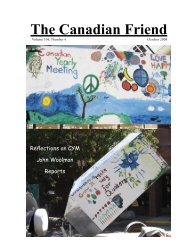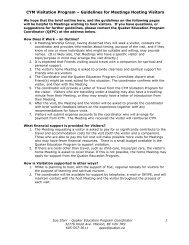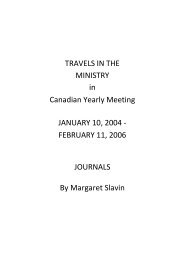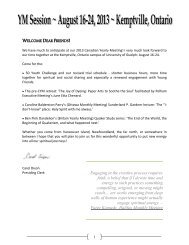Download pdf - Canadian Yearly Meeting
Download pdf - Canadian Yearly Meeting
Download pdf - Canadian Yearly Meeting
Create successful ePaper yourself
Turn your PDF publications into a flip-book with our unique Google optimized e-Paper software.
law to establish any particular church”. They were stillgoing to allow various states to keep their establishedchurches, but they didn’t want one forced down theirthroat by the federal government.This expanded. The Catholics were let in, thenJews and now, we hope, Muslims. Finally, what yougot was a notion of secularism in which all possibleviews could be accommodated. So one basic historicalexperience involved fighting back against a verypowerful religious force; the other evolved out of thequestion, ‘How [do we] live together in diversity andfairness, and in a way that everybody can accept?’ Ourview in the [Bouchard-Taylor] Commission is that wehave arrived at a point in Western societies where thefirst – French – motivation doesn’t really make sense.There are no dominant religious forces trying to pushsociety back. I’m not talking about elsewhere in theworld, Egypt or Saudi Arabia for example, but aboutWestern society. We have to think in terms of the kindof secularism that suits us, which is a secularism ofhow to live together in diversity, not the secularism ofdefending ourselves against religious tyranny. BecauseQuebec has recently emerged from a situation notdissimilar to the French experience, there are somewho want to cleave to this earlier Third Republic sortof secularism. I think that is a mistake in the world inwhich we now live.[*Those with exclusive original French-<strong>Canadian</strong>ancestry.]David SummerhaysMontreal Monthly <strong>Meeting</strong>In Faith, Between Many Faiths?Ellen PyeWhen I started to learn English and French in highschool, one of the early lessons was about the differencebetween objects that could be counted and substancesthat could not, which in English determines the choicebetween ‘many’ and ‘much’. Even in other languages,there were those things for which there was no plural:‘milk’ for instance, or ‘silver’, or ‘peace’. I’ve alwaysfelt that ‘faith’ was in that category, so ‘multifaith’ and‘interfaith’ grate somewhat in my mind.Dana Mullen’s Sunderland P. Gardner Lecture lastyear, had me prick up my ears when she spoke of theconnection between the English word ‘belief’ and theold Dutch word for ‘lovable’. I should have twigged tothat. I’ve always been interested in the derivation ofwords and their change over time, so I nosed aroundin my various dictionaries to find the root words for‘faith’ and ‘belief’, to see where that would take me.Echoes across the European languages have often givenme a deeper understanding of the meanings of certainwords. I hoped the same would happen again.I was not disappointed. The word ‘faith’ comesfrom ‘fides’ in Latin, meaning ‘trust in’; but faith alsomeans ‘trustworthiness’, ‘faithfulness’, and ‘reliability’,so it is a two-way street. With the synonym ‘belief’, itbecomes more interesting. The Latin word for creed– ‘credo’, shares a root with the Latin word for heart– ‘cor’, linking it to the ‘lief’ or ‘dear’ of which Danaspoke. We hold things dear, but if we hold too tightly,what we hold becomes a tenet (from the Latin for ‘tohold’). Credo means ‘I trust’, which would suggestthat there is an element of love in trust.To me, faith does not need a specific content; it ismore a sense of standing on solid ground within, andseeing the surrounding reality as through a slightlyopaque window. Yes, there are times when that groundis subject to quakes and flooding, and doubt becomesfear, with faith tested and stretched almost beyondbearing. Yet, enough persists to regain one’s footingwhen calm returns and the waters recede. It is whenfear prevails and faith falls short that it is tempting tograsp on to something solid outside us: a faith with aspecific, clear content that promises perennial security,becoming tenets that have to be adhered to. That kindof faith is, to me, like a framed painting with veryclear delineations in primary colours and definiteblack and white.20May 2013 - The <strong>Canadian</strong> Friend








